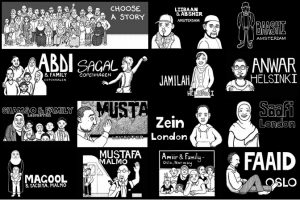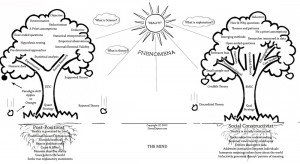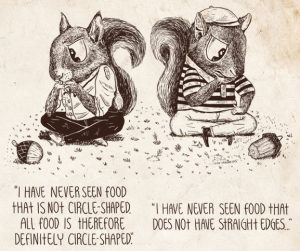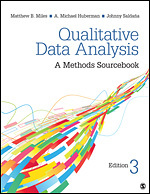The following isn’t from a research project, but in a similar vein to the “The Slow, Costly Death of Mrs. K.” captures Rohan Nuttall’s (a Grade 12 student at Strathcona Composite High School in Edmonton, AB) interpretation of a day in the life of a high school student. The day is marked by time, a linear frame, through which the student moves visually illustrating monotony, distraction, disconnectedness.
The diary of a high-school student: Facebook or chemistry?
8:31 a.m. Wake up. Alarm was set for 6:30. School starts in 15 minutes.
8:35 a.m. Jump out of bed. Head-rush. Pause. Embark on journey to the bathroom. Turn on shower.
8:57 a.m. Step out of shower. Look at the clock. Swear. Look for towel and realize it’s in my room. Swear.
9:08 a.m. Consider eating breakfast. Think about having to take out bowl, find cereal box, find milk, put cereal in bowl, pour milk on cereal, find spoon, lift spoon to mouth multiple times.
9:10 a.m. Decide not to eat breakfast.
9:20 a.m. Anxiously await the arrival of bus. Of course it’s not on time. Blame bus driver for everything. Bus still hasn’t come.
9:20 a.m. Bus comes.
9:59 a.m. Arrive at school. Decide to make the last few minutes of my grade 12 biology class. Realize I have a spare 1st period. Marvel at my dim-wittedness. Forgive bus driver.
10:06 a.m. Bell rings. Realize I’m hungry. At risk of loud stomach rumbling in class decide to get a snack from the cafeteria.
10:10 a.m. Spend $7.00 on a ham sandwich. Get lectured by lunch lady after I question validity of food prices.
10:20 a.m. Still late for class. Give teacher petty excuse–“I was eating breakfast.”
10:45 a.m. Watch teacher spill information over our heads.
11:30 a.m. The all too familiar bell rings for lunch. Students swarm the narrow hallways. It smells like I’m either walking down a perfume aisle or through gym locker room. I can’t quite tell.
11:34 a.m. Get to my locker. Forgot to pack a lunch. Already spent all of my money. Decide to pass the time studying in the library. It’s loud. Kids shouting to each other enthusiastically about how cool GTA 5 is. Ponder the irony of the situation I’m in. There’s a large seagull nonchalantly strolling around in the parking lot.
12:05 p.m. Seagull flies away. Start calculus review. I’ve read the word “derivative” more times than I can remember. What was so wrong with the word “slope”? None of this makes sense.
2:10 p.m. The monotony of the day drags on. Notes. Test. Notes. Test. Worried that I’ll never know the meaning of freedom of interpretation. But hey, at least I’ll have 12 years of practising rote memorization as a life skill. We’re always told that critical thinking is something you do in university. So I guess it makes perfect sense to not bother about it in high school, right?
3:30 p.m. Bell rings for the 13th and last time of the day. Administration thought it would be a good idea to have warning bells. Student autonomy? What a crazy idea.
3:34 p.m. Leave school with bag slightly heavier. 10 pages of chemistry homework even though I know I’m studying economics in university. Useless.
4:05 p.m. Get home. Parents ask how day was. “Fine.” Take dog for a walk. Buckle down to finish homework and study for upcoming tests.
6:00 p.m. Disturbed by parents to eat dinner.
6:50 p.m. Sit down again to study. Phone buzzing every 5 minutes, Facebook messages popping up on laptop screen, music pounding in my ears. It’s no wonder I don’t remember anything I read. Favourite TV show in 10 mins.
7:23 p.m. Sitting on couch in living room. Books on my lap – open – but still only on the table of contents. Fifth time watching this episode.
9:00 p.m. Turn off TV when the news program begins. Head to bedroom. Continue procrastinating.
9:14 p.m. Decide to start chemistry homework. Out of all the questions I’m looking at, the only one that I can think about is “Why do I even have to do this?” What’s the point in homework? Sure, I get that silly yet oddly fulfilling completion mark, but what about the meaningful application? Instead, I’m just spending my time ingraining all of this information in my head for a stupid test at the end of the week only to forget it all on the bus ride home. Doesn’t seem like a very sustainable pedagogical model for the 21st century. So much for saving trees, too.
9:30 p.m. Feeling frustrated. Decide to get ready for bed.
9:36 p.m. Go to bed.
12:34 a.m. Stop texting. Fall asleep.
1:20 a.m. Set alarm for next day.
6:30 a.m. Wake up to alarm. Get ready for school.
7:00am It’s Saturday. Swear.
 Follow
Follow








